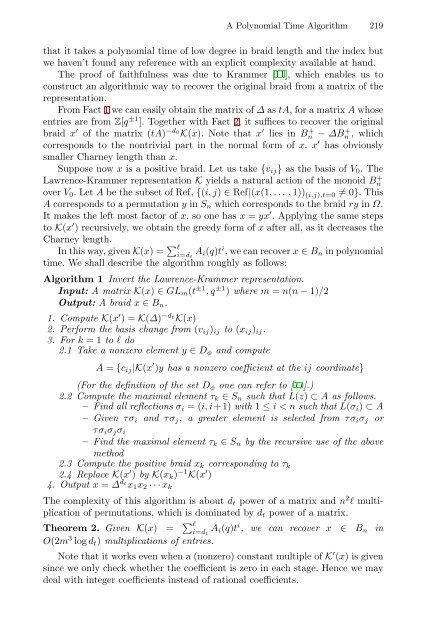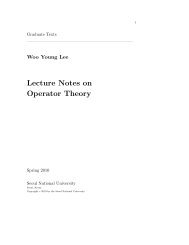A Polynomial Time Algorithm for the Braid Diffie-Hellman Conjugacy ...
A Polynomial Time Algorithm for the Braid Diffie-Hellman Conjugacy ...
A Polynomial Time Algorithm for the Braid Diffie-Hellman Conjugacy ...
Create successful ePaper yourself
Turn your PDF publications into a flip-book with our unique Google optimized e-Paper software.
A <strong>Polynomial</strong> <strong>Time</strong> <strong>Algorithm</strong> 219<br />
that it takes a polynomial time of low degree in braid length and <strong>the</strong> index but<br />
we haven’t found any reference with an explicit complexity available at hand.<br />
The proof of faithfulness was due to Krammer [11], which enables us to<br />
construct an algorithmic way to recover <strong>the</strong> original braid from a matrix of <strong>the</strong><br />
representation.<br />
From Fact 1 we can easily obtain <strong>the</strong> matrix of ∆ as tA, <strong>for</strong> a matrix A whose<br />
entries are from Z[q ±1 ]. Toge<strong>the</strong>r with Fact 2, it suffices to recover <strong>the</strong> original<br />
braid x ′ of <strong>the</strong> matrix (tA) −d0 K(x). Note that x ′ lies in B n + − ∆B n + , which<br />
corresponds to <strong>the</strong> nontrivial part in <strong>the</strong> normal <strong>for</strong>m of x. x ′ has obviously<br />
smaller Charney length than x.<br />
Suppose now x is a positive braid. Let us take {v ij } as <strong>the</strong> basis of V 0 . The<br />
Lawrence-Krammer representation K yields a natural action of <strong>the</strong> monoid B n<br />
+<br />
over V 0 . Let A be <strong>the</strong> subset of Ref, {(i, j) ∈ Ref|(x(1,... ,1)) (i,j),t=0 ≠0}. This<br />
A corresponds to a permutation y in S n which corresponds to <strong>the</strong> braid ry in Ω.<br />
It makes <strong>the</strong> left most factor of x, so one has x = yx ′ . Applying <strong>the</strong> same steps<br />
to K(x ′ ) recursively, we obtain <strong>the</strong> greedy <strong>for</strong>m of x after all, as it decreases <strong>the</strong><br />
Charney length.<br />
In this way, given K(x) = ∑ l<br />
i=d t<br />
A i (q)t i , we can recover x ∈ B n in polynomial<br />
time. We shall describe <strong>the</strong> algorithm roughly as follows:<br />
<strong>Algorithm</strong> 1 Invert <strong>the</strong> Lawrence-Krammer representation.<br />
Input: A matrix K(x) ∈ GL m (t ±1 ,q ±1 ) where m = n(n − 1)/2<br />
Output: A braid x ∈ B n .<br />
1. Compute K(x ′ )=K(∆) −dt K(x)<br />
2. Per<strong>for</strong>m <strong>the</strong> basis change from (v ij ) ij to (x ij ) ij .<br />
3. For k =1to l do<br />
2.1 Take a nonzero element y ∈ D φ and compute<br />
A = {c ij |K(x ′ )y has a nonzero coefficient at <strong>the</strong> ij coordinate}<br />
(For <strong>the</strong> definition of <strong>the</strong> set D φ one can refer to [11].)<br />
2.2 Compute <strong>the</strong> maximal element τ k ∈ S n such that L(z) ⊂ A as follows.<br />
– Find all reflections σ i =(i, i+1) with 1 ≤ i













